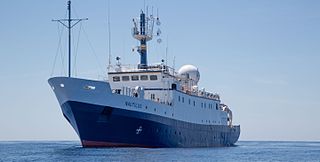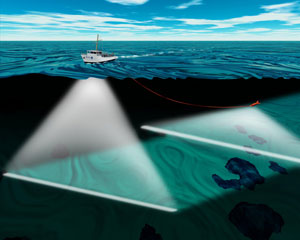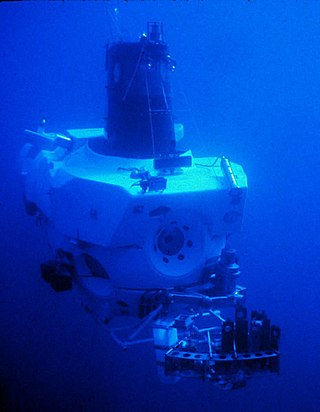Related Research Articles

A remotely operated underwater vehicle (ROUV) or remotely operated vehicle (ROV) is a free-swimming submersible craft used to perform underwater observation, inspection and physical tasks such as valve operations, hydraulic functions and other general tasks within the subsea oil and gas industry, military, scientific and other applications. ROVs can also carry tooling packages for undertaking specific tasks such as pull-in and connection of flexible flowlines and umbilicals, and component replacement. They are often used to visit wrecks at great depths beyond the capacities of submersibles for research purposes, such as the Titanic, amongst others.

The Scorpio is a brand of underwater submersible Remotely Operated Vehicle (ROV) manufactured by Perry Tritech used by sub-sea industries such as the oil industry for general operations, and by the Royal Navy and the United States Navy for submarine rescue services. Originally developed by AMETEK Straza of El Cajon, California, they were subsequently developed by Perry Tritech. Although the design of the original Scorpio is over several decades old, it forms the basis for a current generation of Scorpio-branded ROVs. Scorpio ROVs are named in a sequence following the order of manufacture, such as "Scorpio 17" or "Scorpio 45" which refer to specific ROVs.
The Type 925 Dajiang with NATO reporting name Dajiang, or 大江 in Chinese, meaning Great River, is a type of naval auxiliary ship belonging to the People's Republic of China. Each ship is usually equipped with up to two Type 7103 DSRV class Deep Submergence Rescue Vehicles (DSRVs). The ship is designed to replace the first People's Liberation Army Navy (PLAN) submarine tender PLANS Mount Tai, and the lead ship of the Dajiang class is the Changxingdao. The Type 925 is a submarine tender that can also be used as a submarine rescue ship, and hence, it is designated as a submarine support ship by Chinese.
The Sea Pole class bathyscaphe is a class of bathyscaphe of the People's Republic of China (PRC). They are capable of diving up to 7,000 meters, covering 99.8% of the oceanic floor of the world. Two units of this class are planned, with derivatives to follow and are used by both the civilian and military establishments in China.
Osprey class submersible is a class of submersible of the People's Liberation Army Navy (PLAN) specially designed to perform torpedo retrieving missions at test ranges. This class submersible was highly classified when it originally entered service in 1989, and it was not until more than a decade later in the mid of the first decade of the 21st century when it was revealed to the public, when one of the design team members, the deputy general designer Mr. Sun Xin (孙欣), was publicized in a 2006 interview to disclose some characteristics of the submersible. This class is currently consisted of two boats, Osprey 1 and Osprey 2.
The Chinese 8A4 class ROUV is a remotely operated underwater vehicle (ROUV) used to perform various underwater tasks, ranging from oil platform service to salvage and rescue missions. The 8A4 is a member of a series of related ROUVs developed by the Shenyang Institute of Automation (SIA) in the People's Republic of China (PRC). The predecessor to the 8A4 was the RECON-IV, an improved version of the American RECON-III. The 8A4 itself is an upgraded version of the American AMETEK 2006, and the 7B8 is an improved version of the 8A4.
Sea Dragon-class remotely operated underwater vehicles (ROUVs) are a class of Chinese remotely operated vehicle (ROV) used to perform various underwater tasks such as oil platform service, salvage, and rescue missions. Following the successful development of the original Sea Dragon (海龙), a series of ROUVs based on it have been developed. The original model had a diving capability up to 3,500 meters, but subsequent models were designed to meet a variety of operating conditions.
The Goldfish class remotely operated underwater vehicle (ROUV) is a class of light ROUV developed by the Shenyang Institute of Automation of the Chinese Academy of Science. It is in service with both the People's Liberation Army Navy (PLAN) and other civilian agencies of the People's Republic of China.
Explorer autonomous underwater vehicle (AUV) is a Chinese AUV developed in the People's Republic of China (PRC), first entering service in November 1994. It should not be confused with another two Anglo-American AUVs that share the same name: the American Autonomous Benthic Explorer AUV (ABE) built by Woods Hole Oceanographic Institution, and the British Columbia-based International Submarine Engineering built Canadian Explorer AUV, which is based on its earlier ARCS AUV. Many Chinese AUVs later developed, such as Wukong, WZODA, CR series, Exploration series, Micro Dragon series, Sea Whale series, Submerged Dragon series AUVs, are all based on experienced gained from Explorer AUV.

EVNautilus is a 68-meter (223 ft) research vessel owned by the Ocean Exploration Trust under the direction of Robert Ballard, the researcher known for finding the wreck of the Titanic and the German battleship Bismarck. The vessel's home port is at the AltaSea facility in San Pedro in the Port of Los Angeles, California. Nautilus is equipped with a team of remotely operated vehicles (ROVs), Hercules, Argus, Little Hercules, and Atalanta, a multibeam mapping system, and mapping tools Diana and Echo, allowing it to conduct deep sea exploration of the ocean to a depth of 4,000 meters (13,000 ft).
Diving support equipment is the equipment used to facilitate a diving operation. It is either not taken into the water during the dive, such as the gas panel and compressor, or is not integral to the actual diving, being there to make the dive easier or safer, such as a surface decompression chamber. Some equipment, like a diving stage, is not easily categorised as diving or support equipment, and may be considered as either.

Striver bathyscaphe is a type of deep-submergence vehicle built in the People's Republic of China (PRC). It was built by China State Shipbuilding Corporation (CSSC). It can accommodate three crew members, and is designed to reach depths of more than 10,000 meters. Striver is equipped with two mechanical arms, seven underwater cameras, seven sonars, hydraulic drills, and other scientific devices. On 10 November 2020, the bottom of the Challenger Deep was reached by Striver with three Chinese scientists onboard whilst livestreaming the descent to a reported depth of 10,909 m (35,791 ft).
CAS benthic landers (BL)s are a series of very little known unmanned underwater vehicles (UUV)s developed by Chinese Academy of Sciences (CAS) in the People's Republic of China (PRC). As of the early 2020s, a total of five have been identified.
CSSC unmanned vehicles (UUV)s are uncrewed vehicles developed in the People's Republic of China (PRC) by China State Shipbuilding Corporation (CSSC), most of which are in service with various Chinese governmental agencies/departments, and government-owned enterprises.
Hadal 1 ARV is a type of unmanned underwater vehicle (UUV) built in the People's Republic of China (PRC). ARV stands for Autonomous Remotely-controlled Vehicle, an idea pioneered in China by Shenyang Institute of Automation (SIA) of Chinese Academy of Sciences (CAS), and SIA is also the developer of Hadal 1 ARV, and its predecessor Hadal ARV, as well as Arctic ARV, the predecessor of Hadal ARV. Hadal 1 and its predecessor Hadal, and earlier Arctic series ARVs are the Chinese counterparts of Nereus hybrid unmanned underwater vehicle (UUV), because just like Nereus hybrid UUV, these ARVs can operate both as a AUV or a ROUV. The general designer of Hadal 1 ARV is Mr. Tang Yuan-Gui (唐元贵).
Hadal ARV is a type of very little known unmanned underwater vehicle (UUV) built in the People's Republic of China (PRC). ARV stands for Autonomous Remotely-controlled Vehicle, an idea pioneered in China by Shenyang Institute of Automation (SIA) of Chinese Academy of Sciences (CAS), and SIA is also the developer of Hadal ARV and its predecessor Arctic ARV, as well as Hadal 1 ARV, the successor of Hadal ARV. Hadal and its predecessor Arctic series ARVs are the Chinese counterparts of Nereus hybrid unmanned underwater vehicle, because just like Nereus hybrid UUV, these ARVs can operate both as an AUV or a ROUV.
Discovery remotely operated underwater vehicle (ROUV) is a type of very little known unmanned underwater vehicle (UUV) originally built in Great Britain by British firm Specialist Machine Development (SMD) Limited for the People's Republic of China (PRC). and the British firm was later purchased by CSR Corporation Limited in April 2015.
PWT unmanned underwater vehicles (UUV)s are uncrewed vehicles developed in the People's Republic of China (PRC) by PWT in Wuhan, most of which are in service with various Chinese governmental agencies/departments, and government-owned enterprises.

An underwater survey is a survey performed in an underwater environment or conducted remotely on an underwater object or region. Survey can have several meanings. The word originates in Medieval Latin with meanings of looking over and detailed study of a subject. One meaning is the accurate measurement of a geographical region, usually with the intention of plotting the positions of features as a scale map of the region. This meaning is often used in scientific contexts, and also in civil engineering and mineral extraction. Another meaning, often used in a civil, structural, or marine engineering context, is the inspection of a structure or vessel to compare actual condition with the specified nominal condition, usually with the purpose of reporting on the actual condition and compliance with, or deviations from, the nominal condition, for quality control, damage assessment, valuation, insurance, maintenance, and similar purposes. In other contexts it can mean inspection of a region to establish presence and distribution of specified content, such as living organisms, either to establish a baseline, or to compare with a baseline.

Underwater exploration is the exploration of any underwater environment, either by direct observation by the explorer, or by remote observation and measurement under the direction of the investigators. Systematic, targeted exploration is the most effective method to increase understanding of the ocean and other underwater regions, so they can be effectively managed, conserved, regulated, and their resources discovered, accessed, and used. Less than 10% of the ocean has been mapped in any detail, less has been visually observed, and the total diversity of life and distribution of populations is similarly obscure.
References
- 1 2 3 4 5 6 7 8 9 10 "SJTU ROUVs" (in Simplified Chinese). April 6, 2006.
- 1 2 3 4 5 6 7 8 9 10 11 12 "SJTU ROVs" (in Simplified Chinese). October 21, 2013.
- 1 2 3 4 5 6 7 8 9 10 11 12 "SJT, JH-1 & 8H4" (in Simplified Chinese). Retrieved March 25, 2022.
- 1 2 3 4 5 "HR series ROUVs" (PDF) (in Simplified Chinese). December 31, 2000.
- ↑ "SJT-klass ROUV". wikipredia.net. Retrieved 2022-05-06.
- 1 2 "HR-02 & HR-03 ROVs" (in Simplified Chinese). June 3, 2021.
- 1 2 "Heavy engineering ROUV" (in Simplified Chinese). Retrieved March 30, 2022.
- 1 2 "Max electrical ROUV" (in Simplified Chinese). Retrieved March 30, 2022.
- 1 2 "Medium engineering ROUV" (in Simplified Chinese). Retrieved March 30, 2022.
- ↑ "Dragon Emperor ROV". Sohu (in Simplified Chinese). January 21, 2018.
- ↑ "Dragon Emperor ROUV" (in Simplified Chinese). February 28, 2017.[ permanent dead link ]
- ↑ "Dragon Emperor UUV" (in Simplified Chinese). October 25, 2013.
- ↑ "Dragon Emperor" (in Simplified Chinese). Retrieved March 25, 2022.
- ↑ "JTD-01 Deep Eel I ROUV" (in Simplified Chinese). July 2, 2012.
- 1 2 "Walrus 1500 ROUV" (in Simplified Chinese). Retrieved March 30, 2022.